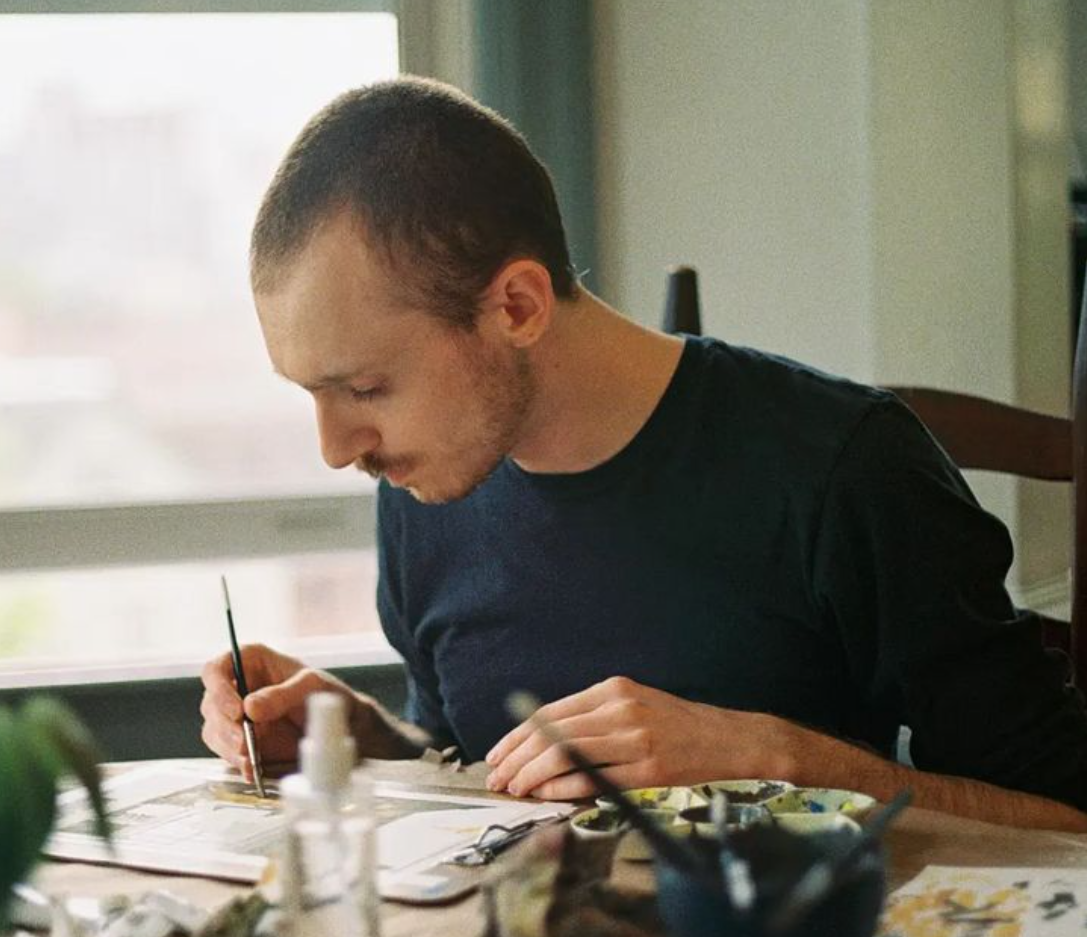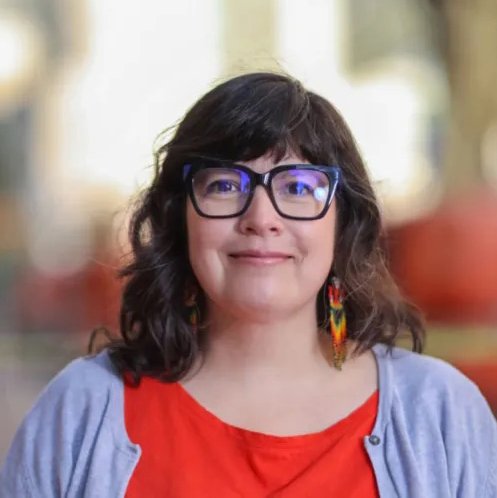Armed in “Gun Paradise”
Illustration by Franco Zacha for palabra
A look at the oldest gun show in Texas shows the connection some residents have to the gun culture despite attempts by the Biden administration to implement more regulations.
Haz clic aquí para leer este reportaje en español.
Watch out for me. I have a gun. It’s empty and tied to a shelf with a cord. I don’t know how to handle it. I try to mimic the movements that I have seen before. I don’t get the mechanism. I don’t even know which one is my dominant eye; like a total novice. I aim to nowhere and then align the sight with the tip of the barrel using the rear sight. It feels so weird. I’m like “Deadpool” without his mask. I’m Travis Bickle on “Taxi Driver.”
I’m at the Original Fort Worth Gun Show at the Will Rogers Center west of Dallas known as the largest and one of the oldest firearms shows in Texas. I paid $10 to get in because I’m not under 11 or a uniformed police officer, which are the only ways they let you in for free. This state, to which I immigrated two years ago, has been called a “gun paradise.” The name comes from Republican Gov. Greg Abbott’s policies that made guns available to almost anyone, even though Texas has a record 27 deaths and 113 injured people in 26 mass shootings in the first nine months of 2024.
I need to know how safe I am without one, mainly because Latinos are twice as likely as non-Hispanic white Americans to be murdered by firearms and four times as likely to be injured by them.
Someone hands me a flyer at the fair gate with safety precautions: fingers off the trigger and always aim in a safe direction. A police officer wearing a white hat checks that anyone with firearms brings them in unloaded.
Inside the fair, a Mossberg Maverick 88 shotgun costs $300. It has a scary-long barrel. For $700 you can buy a Beretta pistol, and for $949.99 a Kalashnikov machine gun. An AR-15 semi-automatic rifle is available for $599.99 — the same model that 18-year-old Salvador Ramos bought and used to kill 19 children and two teachers two years ago at Robb Elementary School in Uvalde, Texas, almost six hours from here.
Everything looks violent. Yet, it seems like an everyday fair. There is a man with a prosthetic leg. There are dogs for adoption. A woman feeds her baby with a bottle. Another woman carries a shotgun on her shoulder; she wears shorts and sneakers, and the gun is nearly her size. A man in flip-flops studies a rifle. The New Testament and bullets are sold in the same stand, which also sells first-aid kits. Children run through people’s legs. A young boy quickly opens a Glock pistol. Someone bumps into me and apologizes.
I notice a lead gun-shaped piece on one of the 1,200 tables. I ask a seller if it’s a toy, but it’s a prototype for testing holsters. The seller, a 70-year-old man, is trying to persuade me about the importance of holsters. Some time ago, his daughter was attacked from behind by a man on the street. She had a holster to carry the revolver under her arm. Almost motionless as she was, she grabbed it and shot the man. “Women should have their guns,” the seller tells me. He makes the holsters at home, blank or with embossed designs, and each is designed to fit a specific part of the body.
‘It’s paradoxical. Nobody would have to worry about another weapon if nobody had one.’
There are old collectible weapons and shiny new ones. For $5, a sharpener can make dented knives look like new. There are pepper sprays, telescopic sights, sharp knuckle dusters, knives hidden in hair combs, or with designs of pink cats, “Batman,” and “The Punisher.” Some retailers walk among the public selling shotguns, with signs that specify their price and model. They offer those shotguns to exhibitors or try to make exchanges. Several people are like that, silently hawking.
There is a fancy table with elaborate and extravagant pistols that look like peacocks. One gun, for example, is all shiny gold with the phrase “El Jefe de Jefes,” (the chief of all chiefs), which in Mexico refers to the most influential drug lord. Another one has a green handle and has “El Gallo” (the rooster) stamped on it, which is a way of saying brave. They all cost around $4,000. It’s like a narco culture altar. I’ve seen very few Latinos here.
Latino voters, in general, are not gun-friendly. Only 38% of them support guns, according to the Pew Research Center. However, more than half of Latinos who support the Republican Party prioritize gun ownership over gun control.
Illustration by Franco Zacha for palabra
Tony, a 22-year-old Mexican I meet on the escalator while I’m going out for a smoke, tells me he’s in favor of guns as long as they’re used for self-defense. “Texas is violent. Do you know how many murders have happened in schools?” Of course, I know. Just this year, there was one in April in Arlington and another in August in Houston. Two people have died in the 66 shooting incidents that have occurred so far this year in Texas schools, and five have been injured. I ask Tony if I can turn on my recorder while he speaks. He doesn’t reply. Instead, he starts walking quickly to the parking lot. “I don’t usually come to these kinds of events,” he says.
It’s paradoxical. Nobody would have to worry about another weapon if nobody had one. People would fight with kicks, teeth, and fists. That’s our natural arsenal. It would be fairer.
Walking in the same parking lot I meet Joseph, who is 25 years old and Mexican like Tony. He says he likes firearms, but they have to be under control. “Since my son was born, I always carry my gun when I go out with him. But I won’t pull it out if I don’t have to.” He doesn’t have the gun or his son at the fair. Joseph says he would vote for Republican presidential candidate Donald Trump, like, probably, everyone else at the gun show. But he will not vote.
God is no more omnipresent than Trump here, nor more praised. There are posters, caps, key chains, and flags with inscriptions saying “Jesus is my savior, Trump is my president.” His face is on a fake hundred-dollar bill. Postcards and stickers with a dramatic photo of Trump after surviving the attack in which he was injured last July: his fist raised, his face spotted in blood, surrounded by Secret Service agents. An older man also carries that same photo on the back of his wheelchair. Other phrases are visible, like, “Make America Great Again,” and “Biden wasn’t elected, he was installed like a toilet.” Trump, Trump.
The Republican nominee pledged in February to protect the rights of gun owners. At a meeting with members of the National Rifle Association, the former president proclaimed himself, “The best friend that gun owners have ever had in the White House,” He also mentioned that he did not give in on this issue during his time as president, despite the pressures that, he said, were exerted on him.
‘I know that they blame those who sell firearms because of the things that have happened. But that is a business just like a supermarket.’
“I will always vote against what the Democrats say,” says María Peña, a Cuban American resident of Dallas who will vote in the United States for the first time this year. You can guess who she will vote for. I ask her whether the proposals on this matter influence her decision. She answers yes, that she agrees with some regulations but not with others.
“What regulations do you agree with?” I ask her at the fair.
“I agree with those regulations that improve control on who carries weapons and where weapons are used, but not with those that eliminate them.”
Support the voices of independent journalists.Until Dec. 31, your donations will be matched dollar-for-dollar. 
|
The Democratic Party has not proposed eradicating guns, as Trump has alleged. At a campaign rally in Atlanta in August, the billionaire claimed his Democratic rival, Kamala Harris, “supports mandatory gun confiscation.” This issue, he said, would leave Americans “defenseless.” Harris, however, has said she does support the Second Amendment but with “reasonable security laws.”
“We are not going to take away anyone’s weapons, so stop lying about these things all the time,” the vice president said during the debate between the two candidates in September. She mentioned that she owns a gun, as does Tim Walz, the Democratic candidate for vice president.
So far, President Joe Biden and Harris have proposed banning assault rifles (such as AR-15s) and high-capacity magazines. They also support strengthening criminal background checks on gun buyers.
A month after the Uvalde massacre, Congress approved — and the president signed — the Bipartisan Safer Communities Act, the most important law on firearms control in nearly three decades. Until then, a loophole in the law allowed gun sales without registration and criminal background checks at fairs like this gun show. The new law changed that. Now, all gun dealers must run criminal background checks on minors under 21, among other provisions of the law.
María Peña, the Cuban American woman who plans to vote for Trump, says she has had a .380 pistol for six or seven years. At the time, she bought it and the sellers kept the gun until the background check was done, and she didn’t get the gun until they confirmed she was clean. It was a process that lasted two or three days. An exhibitor from the fair explains that the background check during the exhibition can take about 15 minutes. If you don’t have a permit to carry weapons, you can still get a firearm with your driver’s license if you are over 21 and pass the background check. This has been allowed by local law since 2021.
Illustration by Franco Zacha for palabra
The exhibitor knows I am a beginner and recommends a safer gun. He tells me about an accident that happened a couple of months ago at an event like this. An employee shot another employee in the chest. No one was killed. That's why he insists on having the gun’s safety on at all times. He also advises me to choose a light weapon that can hold many bullets.
Do I have to upkeep the gun? I ask. Where do I get ammunition? Jorge Estrada, a Guatemalan man, explains that I must clean it when I use it and, from time to time, add oil. It’s simple. “My gun is highly requested; getting bullets is sometimes difficult. They only sell you two boxes at a time,” he tells me. He has owned a Smith & Wesson 9mm for five years. It cost him $550 at a sporting goods store, the same one where a box of 115 bullets costs about $25.
“Have you ever had to use it?”
“Not yet, thank God”, Estrada says .
“Would you be afraid to do it?”
“It depends. If I am in a dangerous situation, then, of course, I will have to use it.”
His job is to collect money from remittance agencies and deposit it in banks. He carries cash. That's why he says he’s protected. “But I am very cautious about that. I have children at home, so I keep it in a safe place, and I take the magazine off, just in case someone finds it and wants to play with it.”
Estrada voted for Biden in the last election and will now vote for Trump. He has been a citizen for about 20 years and does not consider himself a Democrat or a Republican. “What the Democrats want to do is put more locks on firearms so that fewer people can buy them. But it’s not like you go into the store and buy one as if it were gum. I know that they blame those who sell firearms because of the things that have happened. But that is a business just like a supermarket.”
A green-eyed man walks around wearing a bulletproof vest like a tuxedo jacket. Another man, with a beard, wearing a plaid shirt and a camouflage cap, is armed like a wannabe soldier in paradise: rifle on his back, pistols on his waist, one short and the other up to the knee. He talks to two other men; they drink sodas and laugh. A boy skates by.
Among the most expensive items I see is a nickel-plated Chiappa Rhino revolver selling for $1,299.99. A Colt 1911 .38 Super pistol is selling for $3,199 and a Barrett 82A1 sniper rifle is going for $11,050. It is a rehearsal for a war against no one in case a real war breaks out. So, just in case, I’m considering buying a Taser, which costs $20 and is good enough to at least zap a criminal who breaks into my house, and it’ll allow me to run away like a deer before he wakes up.
Yet, maybe no one will ever sneak into my house, and then I’ll have bought it for fun.
You never know.
—
Jesús Jank Curbelo is a Cuban journalist. He has written articles in English and Spanish for outlets in the United States, Argentina, and Peru, among other countries. He is the author of a novel titled, “Los Perros” (2017). @jankcurbelo
Franco Zacha is an illustrator from Buenos Aires, Argentina. To him, illustration is the language of the heart. By combining the world he observes with carefully crafted concepts, Franco captures emotions through the lens of solemnity and beauty. Today, his work is frequently published in the pages of The New York Times, The New Yorker, and The Atlantic. @francozacha
Wendy Selene Pérez is a Mexican journalist based in Texas. She has worked as a local reporter, data journalist, and columnist for two decades in Mexico, Argentina, and the United States. Her work focuses primarily on social justice, forced disappearances, and accountability. She has worked with El País, Animal Político, Letras Libres, and The Texas Tribune, and is an editor with palabra. Pérez has twice won the National Journalism Award in Mexico. @wendyselene











